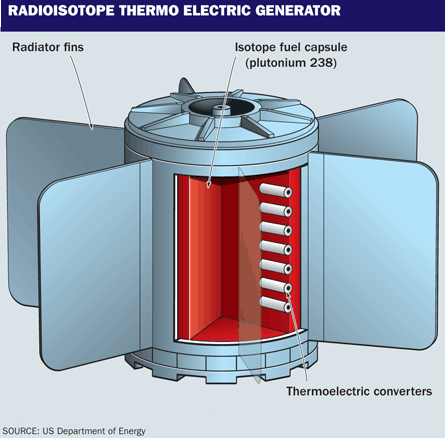On Earth, nuclear power is controversial - but for deep space missions it is a necessity. However, the plutonium driving spacecraft power systems is invaluable not only for its ability to keep electricity flowing where solar cells cannot; Pu-238 is also in short supply.
So rare is it that European Space Agency work on radioisotope power systems spearheaded by the agency's new UK facility will initially be done without the key ingredient.
Nuclear power is critical to the 2018 ESA-NASA ExoMars Martian rovers mission and the UK's Moonlite project. Moonlite is on hold for budgetary reasons, but would use a radioisotope heater unit. More recently two ESA-NASA joint missions, Cassini-Huygens and Ulysses, used nuclear power. More flights are planned, such as the Europa Jupiter System Mission.
In 2009 the US National Academy of Sciences concluded that nuclear energy for space is a high priority because solar arrays and batteries cannot provide enough electricity when a spacecraft, lander or rover is flying in darkness or battery-sapping extreme cold. And such conditions can persist for days or weeks, or permanently depending on the planet, moon or crater being explored.
 |
|---|
The USA has launched 26 civil and military nuclear-powered missions including Voyagers 1 and 2. Launched in 1977 they will transmit data from beyond the solar system until 2020, when their atomic energy runs out.
The academy also cited "numerous studies" that found Plutonium-238 (Pu-238) to be the best radioisotope because of its 87.7-year half life, its high power density at 0.57 watts per gram and its low external radiation levels. As it is no longer manufactured, re-establishing US Pu-238 production was another academy recommendation - with a $150 million price tag. NASA has now been funded to restart production.
Another challenge is conversion efficiency. Existing radioisotope thermoelectric generators convert only a few percent of the heat energy released. The USA is investigating Stirling engine technology as a way to improve efficiency.
According to British National Space Centre (BNSC) documentation, the Harwell facility will not initially handle radioactive material for radioisotope power systems, but could in future when one is tested as part of a spacecraft's system. A demonstration of a European radioisotope power system could come after 2011, when ESA's member states next meet to hammer out a budget.
BNSC space science director David Parker says that Harwell will study Americium as an alternative to Pu-238. He says Americium's longer half-life - more than 150 years - makes it a good alternative; its heat output is less than that of Pu-238, but improved thermal conversion could offset that. He points to Oxford University research on infrared-related technology as one conversion solution.
Whether Americium will solve the plutonium supply crunch is unclear. The US Argonne National Laboratory says Americium isotopes are made from plutonium isotopes. Battery technology is also on the Harwell agenda.
| What is a radioisotope power system? A radioisotope power system (RPS) is a generic term for different types of power sources that use radioisotopes. Operational systems for spacecraft using RPS have been designed to withstand a catastrophic launch failure to avoid radioactive fallout.
A Radioisotope heater unit (RHU) is small and can be the size of a stack of pennies. It can have just 40g (1.4oz) of plutonium dioxide in a ceramic case. Heat from the plutonium dioxide enables spacecraft system temperature control.
A radioisotope thermoelectric generator (RTG) is not like terrestrial nuclear reactors. An RTG has no moving parts and uses neither fission nor fusion processes. Heat from the natural radioactive decay of plutonium 238, a non-weapons grade isotope, is used to generate electricity using solid-state thermoelectric converters. An RTG can have as much as 4.5kg (9.9lb) of plutonium.
A Stirling engine can convert heat from the decay of plutonium 238 into electricity for the RTG. According to NASA, a Stirling engine could use a quarter of the plutonium needed by an RTG. The Stirling engine, named after 19th century UK inventor Robert Stirling, works by absorbing heat outside its cylinder(s) to heat and change the pressure of the gas inside, causing piston movement. |
Source: Flight International



















